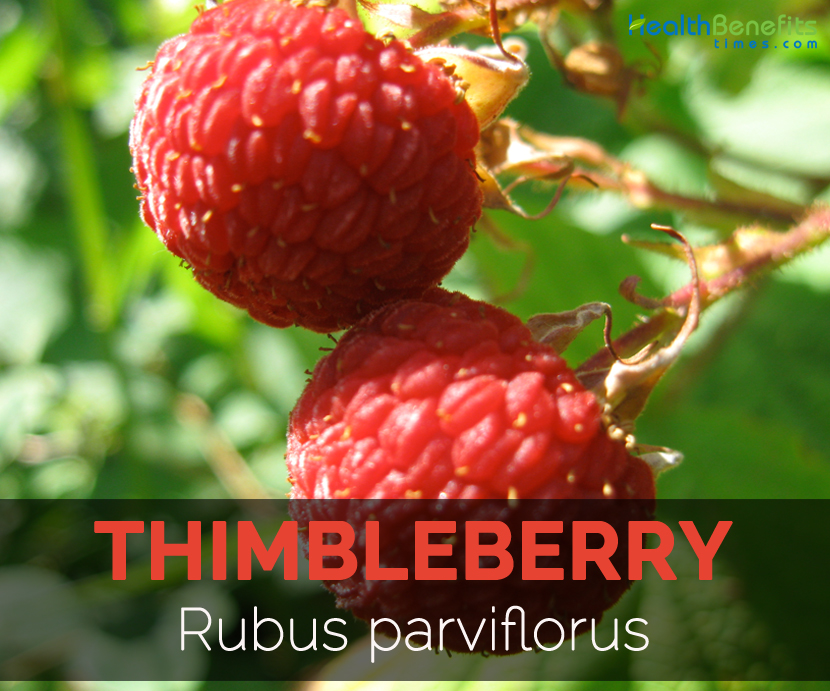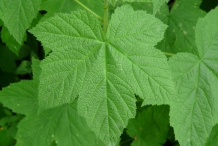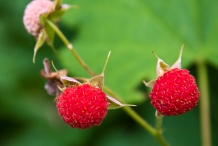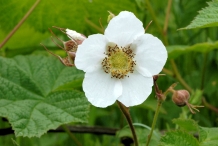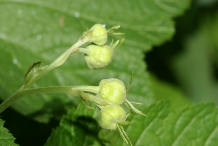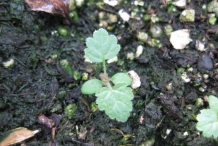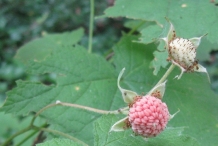Though Thimbleberry is found in various habitats, it prefers open and moist sites. It could be found in riparian zones, shrublands, coniferous, deciduous and mixed forests. It is not tolerable to waterlogging. It is mostly found in well-drained upper floodplains or lower floodplains. The plant has white flowers which attracts birds and butterflies.
History
It extends from East to Rocky Mountains and to the Great Lakes Region discontinuously. It is distributed to Alaska, Ontario, Michigan and South to Northern regions of Mexico. It is commonly grown in open, stream banks, wooded hillsides, borders, canyons and roadsides.
Plant
Thimbleberry is a deciduous, perennial, erect, upright shrub growing to 1-8 feet height and 1.5 centimeters (0.59 inches) in diameter. Leaves are alternate, temate, maple shaped, toothed; green above and white-tomentose beneath which is 7-10 cm long. Flowers are white, rose shaped; 4-5 cm across and 5-6 mm long. Fruits are ovoid and cup shaped. The stems are red, thorn less, zigzag, 2-15 mm in diameter and 1.5-2 cm wide.
Traditional uses
- The berries, leaves and roots helps to treat stomach ache, wounds, reduce scarring as well as swelling.
- The berries are consumed fresh as well as dried.
- The young roots, shoots and leaves are used to cure ailments.
- A tea made from leaves and roots act as a tonic to treat nausea, diarrhea, vomiting and dysentery.
- It helps to tone, strengthen stomach and increase appetite.
- Thimbleberry is also used to enhance immune system and prevent scurvy.
- A poultice made from dried powdered leaves is used to treat burns and wounds.
- The crushed leaves help to treat acne.
- A decoction made from roots is used to treat acne.
- The leaves are used to treat vomiting and nausea.
- A tea is used to treat stomach ailments, dysentery, diarrhea and anemia.
- A poultice made from dried powdered leaves treats wounds as well as burns.
- The crushed leaves are rubbed on the skin to cure blackheads and pimples.
- The roots are used as tonic and appetizer.
- To poultice of leaves are used to cure swelling.
- The flowers and leaves of Thimbleberry provide relief from stomach complaints.
- Young shoots are considered as antiscorbutic and alterative.
Precautions
- The merely wilted leaves are toxic.
- The pregnant women should avoid the use of Thimbleberry.
- The excessive consumption can result in adverse health effects.
How to Eat
- Young shoots and leaves are consumed as teas.
- These berries are consumed raw or cooked as jelly or jam.
- The berries dried and consumed as dry fruits.
- The fruit are added to fruit pies, milkshakes and other desserts.
- The shoots are consumed raw or prepared as green vegetable.
- Berries are also mixed with other berries.
Other Facts
- The fruit is dried for winter and consumed fresh in the summer.
- The boiled bark is used to make soap and medicinal tea was made from leaves.
- The powdered leaves are applied to burns which help to minimize scarring.
- Due to the softness of leaves they are also referred as nature wipes.
- Barks and leaves are used in facial steams for the oily skin.
- They are also used as care products for herbal baths and hair rinses.
- This plant is used to eradicate toothaches.
- The flowers of this plant are biggest among the plants from the genus Rubus.
- These plants are tolerable to mild draughts.
References:
http://www.cabi.org/isc/datasheet/48013
https://thenorthwestforager.com/2014/08/17/thimbleberry/
http://montana.plant-life.org/species/rubus_parvi.htm
http://www.naturalmedicinalherbs.net/herbs/r/rubus-parviflorus=thimbleberry.php
http://www.fs.fed.us/wildflowers/plant-of-the-week/rubus_parviflorus.shtml
http://www.onlyfoods.net/thimbleberry.html
http://nativeplantspnw.com/thimbleberry-rubus-parviflorus/
http://pages.uoregon.edu/ecostudy/elp/hendricks/pdf_files/rubus_parviflorus.pdf
Comments
comments
| Thimbleberry Quick Facts | |
|---|---|
| Name: | Thimbleberry |
| Scientific Name: | Rubus parviflorus |
| Origin | Western North America from South Alaska as far as New Mexico, California, Chihuahua and San Luis Potosi |
| Colors | Red (Fruit) |
| Shapes | Ovoid, cup shaped (Fruit) |
| Taste | Sweet |
| More facts about Thimbleberry | |
